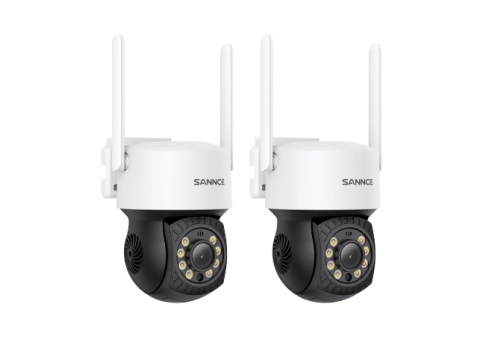Outdoor IP Surveillance Cameras
Wireless (WiFi) Options
Specifications and Features
Setting up outdoor IP surveillance systems requires reliable performance under varying weather conditions. This article highlights key features and options for outdoor IP cameras, tailored to meet different surveillance needs.
Outdoor setups generally involve two camera types:
- Fixed Cameras
- PTZ (Pan-Tilt-Zoom) Cameras
If your system runs autonomously without a live operator, fixed cameras are often the better choice. While PTZ cameras can adjust positions via automation or motion detection, they're less cost-effective. The price of a single PTZ camera can often cover several high-quality fixed cameras or panoramic models. These options ensure constant surveillance of the area, making them ideal for security-sensitive applications.
PTZ outdoor cameras, often referred to as Speed Dome Cameras, are best for high-security environments. Their motorized zoom lenses can track and focus on suspicious activities in real-time, making them indispensable in airports, malls, or large commercial properties. The added benefit? IP technology minimizes the wiring needed for these advanced systems.
Wireless Outdoor WiFi Cameras
Outdoor WiFi cameras simplify installation by enabling data transmission without cables. Unlike indoor setups, where walls and interference can disrupt connections, outdoor environments make it easier to achieve clear 100-meter line-of-sight coverage. For extended ranges, use directional antennas or WiFi repeaters for a robust connection.
Some WiFi cameras also support GSM technology, allowing data transfer via mobile networks like 3G/4G LTE. With this approach, you can transmit footage to cloud servers, provided the installation area has reliable mobile coverage. A GSM Signal Booster can amplify weak signals, but it's worth noting that boosting doesn't always work if the camera is far from the amplifier.
A downside of WiFi cameras is their reliance on nearby power sources. Running power cables over long distances undermines the wireless advantage. Therefore, ensure an accessible power connection—whether it's a 220V residential outlet or a dedicated outdoor power grid.
Key Requirements for Outdoor IP Cameras
Temperature Resistance
Outdoor IP cameras must withstand extreme temperatures. While many advertise functionality down to -22°F (-30°C), the reality is more complex. For example, some cameras may only "start" at -4°F (-20°C) without preheating. Similarly, overheating during summer may necessitate built-in cooling systems.Line Length Considerations
When using Ethernet connections, the signal weakens over distances exceeding 328 feet (100 meters). Additional switches or repeaters may be required, adding to setup costs.Weatherproof Build
Outdoor IP cameras often come with vandal-resistant or weatherproof housings:- Dome Cameras: Better suited for vandal-prone areas.
- Bullet Cameras: Easier to install but less resistant to intentional damage.
Night Vision
Most IP cameras are less light-sensitive than analog models, making infrared (IR) illumination essential. Ensure the IR range and beam angle align with your camera's field of view.
Practical Installation Tips
- Power over Ethernet (PoE): Use PoE for a streamlined installation combining power and data in one cable.
- Weather Adaptability: Consider temperature, humidity, and weather-resistant materials for long-term reliability.
- Integration Capabilities: Outdoor IP cameras can connect to a variety of devices, including cloud servers, NVRs, and mobile apps for remote monitoring.
WiFi Camera Use Cases
WiFi outdoor cameras find applications in diverse environments, including:
- Residential properties
- Commercial warehouses and offices
- Public areas like parks, parking lots, and gas stations
- Schools and hospitals
They're also increasingly used for live-streaming landmarks and tourist attractions online. Wireless technology makes these cameras a go-to for places with limited wiring options.
Home and Covert Surveillance
Affordable WiFi cameras have opened up possibilities for average homeowners to enhance their security. Compact indoor models blend seamlessly with home decor and can stream footage directly to your smartphone, even while you're away.
Covert WiFi Cameras
Discreet surveillance cameras are designed for minimal visibility. While these models can be useful, their legal use often comes with restrictions. For example, many countries require clear signage if surveillance is in progress, even in private spaces.
Miniature covert cameras typically include features like:
- Motion Detection: Activates recording only when movement is detected.
- Battery Power: Ensures independent operation.
- Built-in Microphones: For capturing audio along with video.
Despite their small size, most covert cameras are not built to withstand harsh outdoor conditions.
Final Thoughts
Outdoor WiFi cameras offer unmatched flexibility and convenience, but choosing the right model requires attention to specific details like environmental resistance, wireless range, and installation feasibility. Whether securing a single-family home or a large commercial space, these cameras can adapt to virtually any requirement with proper planning.

